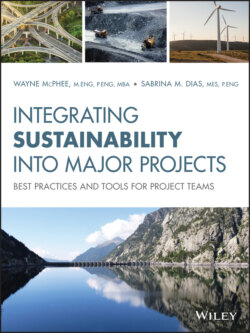Читать книгу Integrating Sustainability Into Major Projects - Wayne McPhee - Страница 53
2.6 Project Lifecycle
ОглавлениеThere are three main pathways in a project lifecycle that are interconnected and interdependent:
Design and delivery
Sustainability
Financial management
The design and delivery pathway has always been well integrated with the financial management pathway. They are closely linked in all aspects from decision making and design to procurement and construction. The sustainability pathway is newer and therefore not as well integrated, but it is becoming more and more critical in the project lifecycle to understand and integrate project sustainability into the overall project lifecycle. Projects have required regulatory approvals for many years, but the big change is the need for community support, not just to ensure regulatory approval but also to de-risk the project and gain project financing.
The transition from two major pathways to three major pathways has left a gap in project planning and project management. The idea that the sustainability pathway can be managed solely by an outside consultant or a junior regulatory specialist is no longer tenable nor sufficient for delivering successful projects. Projects require senior sustainability leadership that can deliver critical sustainability elements and ensure that sustainability issues and challenges are addressed.
Figure 2.4 Three pathways for successful project delivery.
The three pathways each have their own set of approvals and stages to move toward project completion (see Figure 2.4), including project owner approval to move through each stage of the design and delivery pathway, raising financing from internal and external sources, and sustainability approvals that includes permits and community agreements.
Over the life of the project, complex relationships can develop between the three main pathways. There needs to be clear communication among the team members. Everyone needs to understand the challenges and opportunities that other teams face in order to help overcome hurdles and move the entire project forward. A hurdle for one pathway is a hurdle for the entire project, and teams need to understand that everyone is responsible – not just the teams leading each of the pathways. All three pathways need to be part of the same project planning and project scheduling so that everyone understands the potential impacts.
Each of the three pathways are dependent on the other pathways. Having a solid strategy and team for one or two of the pathways is not going to create a successful project without the third stream also producing the required results. In the same way that poor financial management can kill a project with no cash to spend, or a poor design can kill a project with feasibility studies that owners or investors disagree about investing in, poor sustainability management can kill a project with failure to achieve community support, which can lead to protests, lawsuits, and blocked construction sites.
The project team will also change and grow as the project moves along the three pathways. As projects move from feasibility to design and construction, the project team will grow, so it is important to put in place management systems and communication tools to prevent information from getting lost. As the project develops there can also be time gaps between each of the stages and changes in personnel, contractors, and consultants working on the project. Installing systems such as commitments tracking, stakeholder engagement, and managing complaints between project stages is imperative to maintaining project success. See Chapter 8 for details on project management systems and tools.
